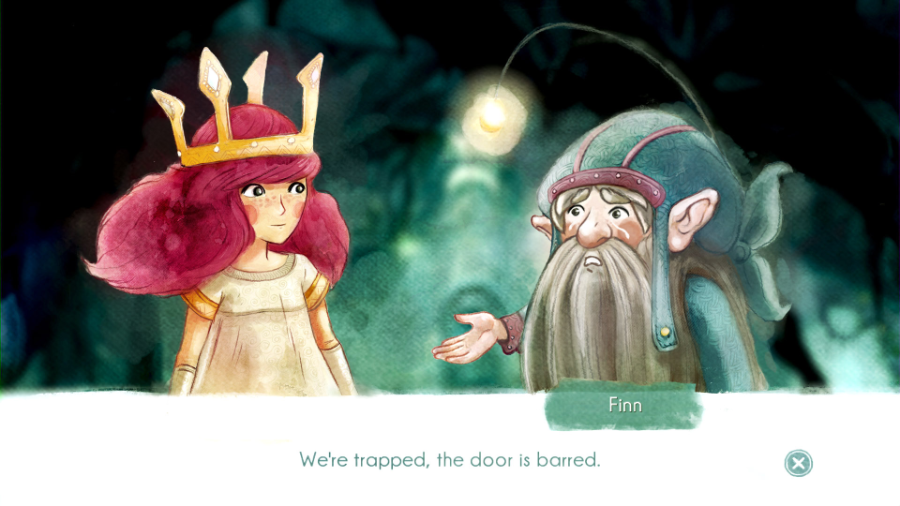I kind of got the impression that this is what we were in for with this game. I still might check it out if/when it's on sale, but I can see myself growing tired of it fairly quickly.
Child of Light Review
|
|
See PixlBit's Review Policies

On 06/02/2014 at 12:00 PM by Daniel Iverson Sparkle and fade. |

Child of Light is an artistic achievement that shines occasionally, but I enjoyed it less the more I played it. If you place a premium on aesthetics or like the simple pleasure of a casual game, it may engage you more consistently.
Child of Light is the video game equivalent of a children’s bedtime storybook. It’s full of beautiful artwork and whimsical characters. It lights a spark and captures your imagination. Then it starts to put you to sleep.
The story centers on Aurora, a young girl from a royal family whose apparent illness actually whisks her off to the fantastic world of Lemuria. There, she begins a quest to recover the sun, the moon, and the stars from a dark adversary. Determined and stubborn, Aurora is an endearing and easily likable protagonist. Whenever she’s hit in battle, her crown falls off and her sword — obviously a few pounds too heavy for her petite stature — drops to the floor. But she always picks them up again, ready to press on.
Unfortunately, Aurora leads a plot that’s more often dull than engaging and even harder to follow. It unfolds entirely through poetic verse, which flows erratically with awkward rhymes that often feel contrived, like the writers tried to force essential information to conform to the style. Perhaps if the poetry were limited to specific instances or supported with voice work, it would be enjoyable.
The game’s audiovisual style is a lot more natural, and it’s a treat. Ubisoft’s Ubi-Art engine brings Lemuria’s dreamy world to life with a muted watercolor palette and beautiful animations. Exploration of its deep forests and mountainous crags is set to an equally beautiful piano score, while rousing orchestral and vocal pieces complement battles. Often, the music would stay with me well after I’d shut off the console.
The world is designed with a mix of wide open spaces and branching paths, each peppered with enough puzzles, traps, and treasures to maintain interest while you explore. Although, with all the choices of where to go, a mini-map would’ve done wonders to aid navigation. Puzzles are easy and quick to solve, often favoring the ever-popular crate and pressure plate, although a few employ more creative light and shadow mechanics.
Battle, however, is where you’ll spend the majority of the time. Combat works like the Active Time Battle system from old Square Enix RPGs, where everyone waits a set time to act. Icons representing both friend and foe move from left to right down a shared time bar. The first 75% of the bar is labeled WAIT, while the remaining 25% is labeled CAST. Whenever one of the icons hits the CAST area, the corresponding battle participant may act. Each action then activates at a different speed.
Defending activates instantly while casting a powerful spell requires waiting another few seconds. If the attack you choose is faster than the enemy’s, you interrupt it — and vice versa. Interruptions are the key to battle. Over the course of the game, you’ll acquire a few tools to manipulate time. Using them effectively is the battle system’s primary strategic element. Misjudge, and you will be hurting.
The battle system repackages concepts you may recognize from other RPGs (like the party member switching mechanic Final Fantasy X popularized). Although it’s more derivative than innovative, it’s also well-balanced and features a decent variety of enemies and skills; I enjoyed it for a while. Like plenty of RPGs before it, Child of Light’s battles eventually succumb to repetition. Individual encounters may be quite protracted, which amplifies the problem.
Outside of battle, you’ll upgrade characters with basic skill trees. In lieu of weapons and armor, characters may craft and equip “occuli” — gems whose functions change depending on whether they’re used for offense, defense, or support. For example, the same gem could add a fire element to attacks, increase resistance to fire, or raise maximum MP depending on where it’s equipped.
The upgrade and occuli systems, like the crate and pressure plate puzzles, are appropriately simple for the scope of a fifteen-hour game. That said, the sum of Child of Light’s simplicities is its biggest weakness. The dull story and diminishing returns of combat leave a game too dependent on its charm, which fades well before the credits roll. To call it style over substance would be unfair, because a technically well-executed game exists beneath the artsy surface. But it’s all too often simply boring to play, and even its best elements remind of at least a half dozen other games I’d sooner recommend.













Comments